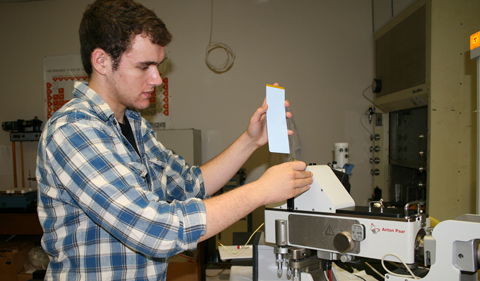By Peter Andrews
B.S. Honors Tutorial College French and College of Arts and Sciences Linguistics, Class of 2018
 I worked in Dr. Gang Chen’s lab, where I studied phase change memory materials (PCMM) that have been used in optical and electric memory devices such as DVDs and cell phone chips. A scientific challenge of PCMM is to understand why the phase change occurs at very high speed and how to further improve the speed. One of the key issues of PCMM is the very early stage of the phase change (i.e., nucleation) of the amorphous materials.
I worked in Dr. Gang Chen’s lab, where I studied phase change memory materials (PCMM) that have been used in optical and electric memory devices such as DVDs and cell phone chips. A scientific challenge of PCMM is to understand why the phase change occurs at very high speed and how to further improve the speed. One of the key issues of PCMM is the very early stage of the phase change (i.e., nucleation) of the amorphous materials.
I used a combined small- and wide-angle X-ray scattering technique to study the nucleation of a prototypical amorphous PCMM (i.e., Ge1Sb2Te4) at temperatures below the crystallization temperature. The X-ray technique enabled me to study the effect of temperature on nucleation just before and after the phase change occurs.
I was in the lab most days during the summer, and Dr. Chen was away for several weeks. When I had questions Dr. Chen arranged for me to check with Mayur Sundararajan, one of Dr. Chen’s graduate students who was working in a second lab next door. Jan Gutwirth, a visiting scholar from the University of Pardubice, Czech Republic, was in the lab using the Small Angle X-Ray Scattering instrument to study homogeneity and phase transformations, so he was a good resource, too. I’m really grateful for the opportunity Dr. Chen gave me to learn more about condensed matter and run the PCMM experiment using state-of-the-art lab equipment.
Peter Andrews – Intern with Dr. Gang Chen – sophomore at Ohio University – Honors Tutorial College – French major




















Comments